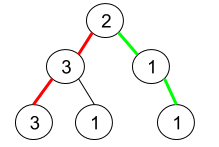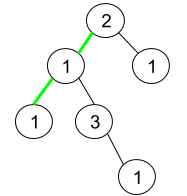Welcome to Subscribe On Youtube
1457. Pseudo-Palindromic Paths in a Binary Tree
Description
Given a binary tree where node values are digits from 1 to 9. A path in the binary tree is said to be pseudo-palindromic if at least one permutation of the node values in the path is a palindrome.
Return the number of pseudo-palindromic paths going from the root node to leaf nodes.
Example 1:

Input: root = [2,3,1,3,1,null,1] Output: 2 Explanation: The figure above represents the given binary tree. There are three paths going from the root node to leaf nodes: the red path [2,3,3], the green path [2,1,1], and the path [2,3,1]. Among these paths only red path and green path are pseudo-palindromic paths since the red path [2,3,3] can be rearranged in [3,2,3] (palindrome) and the green path [2,1,1] can be rearranged in [1,2,1] (palindrome).
Example 2:

Input: root = [2,1,1,1,3,null,null,null,null,null,1] Output: 1 Explanation: The figure above represents the given binary tree. There are three paths going from the root node to leaf nodes: the green path [2,1,1], the path [2,1,3,1], and the path [2,1]. Among these paths only the green path is pseudo-palindromic since [2,1,1] can be rearranged in [1,2,1] (palindrome).
Example 3:
Input: root = [9] Output: 1
Constraints:
- The number of nodes in the tree is in the range
[1, 105]. 1 <= Node.val <= 9
Solutions
Solution 1: DFS + Bit Manipulation
A path is a pseudo-palindromic path if and only if the number of nodes with odd occurrences in the path is $0$ or $1$.
Since the range of the binary tree node values is from $1$ to $9$, for each path from root to leaf, we can use a $10$-bit binary number $mask$ to represent the occurrence status of the node values in the current path. The $i$th bit of $mask$ is $1$ if the node value $i$ appears an odd number of times in the current path, and $0$ if it appears an even number of times. Therefore, a path is a pseudo-palindromic path if and only if $mask \&(mask - 1) = 0$, where $\&$ represents the bitwise AND operation.
Based on the above analysis, we can use the depth-first search method to calculate the number of paths. We define a function $dfs(root, mask)$, which represents the number of pseudo-palindromic paths starting from the current $root$ node and with the current state $mask$. The answer is $dfs(root, 0)$.
The execution logic of the function $dfs(root, mask)$ is as follows:
If $root$ is null, return $0$;
Otherwise, let $mask = mask \oplus 2^{root.val}$, where $\oplus$ represents the bitwise XOR operation.
If $root$ is a leaf node, return $1$ if $mask \&(mask - 1) = 0$, otherwise return $0$;
If $root$ is not a leaf node, return $dfs(root.left, mask) + dfs(root.right, mask)$.
The time complexity is $O(n)$, and the space complexity is $O(n)$. Here, $n$ is the number of nodes in the binary tree.
-
/** * Definition for a binary tree node. * public class TreeNode { * int val; * TreeNode left; * TreeNode right; * TreeNode() {} * TreeNode(int val) { this.val = val; } * TreeNode(int val, TreeNode left, TreeNode right) { * this.val = val; * this.left = left; * this.right = right; * } * } */ class Solution { public int pseudoPalindromicPaths(TreeNode root) { return dfs(root, 0); } private int dfs(TreeNode root, int mask) { if (root == null) { return 0; } mask ^= 1 << root.val; if (root.left == null && root.right == null) { return (mask & (mask - 1)) == 0 ? 1 : 0; } return dfs(root.left, mask) + dfs(root.right, mask); } } -
/** * Definition for a binary tree node. * struct TreeNode { * int val; * TreeNode *left; * TreeNode *right; * TreeNode() : val(0), left(nullptr), right(nullptr) {} * TreeNode(int x) : val(x), left(nullptr), right(nullptr) {} * TreeNode(int x, TreeNode *left, TreeNode *right) : val(x), left(left), right(right) {} * }; */ class Solution { public: int pseudoPalindromicPaths(TreeNode* root) { function<int(TreeNode*, int)> dfs = [&](TreeNode* root, int mask) { if (!root) { return 0; } mask ^= 1 << root->val; if (!root->left && !root->right) { return (mask & (mask - 1)) == 0 ? 1 : 0; } return dfs(root->left, mask) + dfs(root->right, mask); }; return dfs(root, 0); } }; -
# Definition for a binary tree node. # class TreeNode: # def __init__(self, val=0, left=None, right=None): # self.val = val # self.left = left # self.right = right class Solution: def pseudoPalindromicPaths(self, root: Optional[TreeNode]) -> int: def dfs(root: Optional[TreeNode], mask: int): if root is None: return 0 mask ^= 1 << root.val if root.left is None and root.right is None: return int((mask & (mask - 1)) == 0) return dfs(root.left, mask) + dfs(root.right, mask) return dfs(root, 0) -
/** * Definition for a binary tree node. * type TreeNode struct { * Val int * Left *TreeNode * Right *TreeNode * } */ func pseudoPalindromicPaths(root *TreeNode) int { var dfs func(*TreeNode, int) int dfs = func(root *TreeNode, mask int) int { if root == nil { return 0 } mask ^= 1 << root.Val if root.Left == nil && root.Right == nil { if mask&(mask-1) == 0 { return 1 } return 0 } return dfs(root.Left, mask) + dfs(root.Right, mask) } return dfs(root, 0) } -
/** * Definition for a binary tree node. * class TreeNode { * val: number * left: TreeNode | null * right: TreeNode | null * constructor(val?: number, left?: TreeNode | null, right?: TreeNode | null) { * this.val = (val===undefined ? 0 : val) * this.left = (left===undefined ? null : left) * this.right = (right===undefined ? null : right) * } * } */ function pseudoPalindromicPaths(root: TreeNode | null): number { const dfs = (root: TreeNode | null, mask: number): number => { if (!root) { return 0; } mask ^= 1 << root.val; if (!root.left && !root.right) { return (mask & (mask - 1)) === 0 ? 1 : 0; } return dfs(root.left, mask) + dfs(root.right, mask); }; return dfs(root, 0); } -
// Definition for a binary tree node. // #[derive(Debug, PartialEq, Eq)] // pub struct TreeNode { // pub val: i32, // pub left: Option<Rc<RefCell<TreeNode>>>, // pub right: Option<Rc<RefCell<TreeNode>>>, // } // // impl TreeNode { // #[inline] // pub fn new(val: i32) -> Self { // TreeNode { // val, // left: None, // right: None // } // } // } use std::rc::Rc; use std::cell::RefCell; impl Solution { pub fn pseudo_palindromic_paths(root: Option<Rc<RefCell<TreeNode>>>) -> i32 { fn dfs(root: Option<Rc<RefCell<TreeNode>>>, mask: i32) -> i32 { if let Some(node) = root { let mut mask = mask; let val = node.borrow().val; mask ^= 1 << val; if node.borrow().left.is_none() && node.borrow().right.is_none() { return if (mask & (mask - 1)) == 0 { 1 } else { 0 }; } return ( dfs(node.borrow().left.clone(), mask) + dfs(node.borrow().right.clone(), mask) ); } 0 } dfs(root, 0) } }